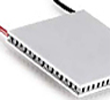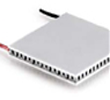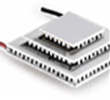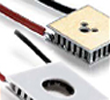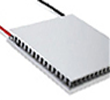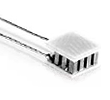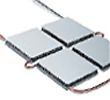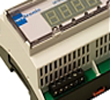The Peltier elements, which are also called thermoelectric modules or TEC, are an electrically operated heat pump. Here, energy in the form of heat is transferred from one side of the module to the other side and has to be dissipated there. The Peltier module is based on the so-called Peltier effect which describes the quasi-inverse of the Seebeck effect. The Peltier effect states that energy can be transported in the form of heat by a current flow in a semiconductor, which creates a temperature difference. The Seebeck effect means that a current flow is obtained when a temperature difference is applied to a semiconductor. The Seebeck effect is used to measure temperature or to harvest electrical energy.
The Peltier element is the a heat pump, which is based on the transport of electric current in a semiconductor.
Thermoelectric modules are often used in the:
- Medical
- laser Technology
- Laboratory / analytical technique
- Gas analysis technique
- For the condensation
- Automotive technology for energy recovery
- military technology
The main advantages of the Peltier element are here:
- Precise control by electricity
- By reversing the polarity,reversal of heat flow can be generated
- Vibration-free operation
- Longevity of the effect (> 20 years)
- Small dimensions
The uwe electronic provides a very large program of Peltier elements which can cover many applications.
30 golden rules for Peltier Technology
- The number of solid-state pairs as well as packet density of Peltier module determines the size of the module.
- On every solid-state pair drops approx. 0.12 Volt. A high number of solid-state pairs increases maximum possible voltage and the current can be thereby decreased.
- High current influence the life time of the module, because it extends microtears of solid-state material with the time.
- High current conduct higher thermal warming and therefore it lowers efficiency.
- The relation of cooling power (Qc) to the used current can be seen mathematically as an exponential approach to the maximum value. Consequently a lot of electric energy must be engaged for the last 30% of the maximum chill achievement.
- The heat dissipation on warm side of the Peltier module is the sum of the cooling power and the engaged electric energy (working energy).
- The efficiency of Peltier module is the relation of thermal transfer to the engaged electric energy.
- Very high efficiency of cooling with Peltier is realized by operation around approx. 50% of voltage / current maximum value.
- The information of maximum cooling power Qc of Peltier module is based on temperature difference between both sides (0 Kelvin), a maximum provided current / voltage and an ambient temperature of 300K (27°C). The real cooling power is lower and can be estimated with the help of a performance diagram.
- Standard modules reach under vacuum condition and 300K (27°C) ambient temperature a maximum temperature difference of approx. 70 Kelvin.
- High-quality modules can reach values of about 72 Kelvin and more, while low-cost modules reach scarcely about 60 Kelvin.
- Special modules like multistage cascades generate a difference in temperature up to 120K. Disadvantage is low thermal pumping and the high price.
- A good heat dissipation on warm side of Peltier module improves the cooling power, efficiency and maximum temperature difference deltaT.
- The heat dissipation to the surroundings depends on the capability of the heat sink. A higher active surface of the heat sink (dimension as well number of fins) improves the thermal resistance.
- Big fans with high air flow improve the thermal resistance of the heat sink.
- Direct blowing on heat sinks body is most efficient, because the highest heat is always given on the ground of the body.
- Liquid heat sinks mostly have even higher thermal qualities, nevertheless they are substantially more cost-intensive.
- Between Peltier module and heat sink should be applied a good thermal interface material (thermal pads, thermal paste or thermal adhesive) for increasing the thermal transmission
- A very good thermal transmission between materials is reachable with a thin layer of thermal grease, because it can adapt itself to the microscopic unevenness.
- PCM (phase change material) show especially high filling factor. It moisten in the surfaces even better than normal thermal grease and also have the advantage that it doesn’t dry up.
- High contact pressure also improves the thermal transmission, but at assembly it is very important that shearing force is prevented.
- Contact pressure to Peltier module should be between 3-8 kg / cm ².
- Only small modules till maximum 12x12mm can be coated optionally with a metallization. They can be soldered in the manufacturing process directly on the heat sink.
- The maximum short-term operation temperature should be always 20-30°C below the solder temperature of the plumb (139°C; 183°C and 232°C).
- A longer-term use of a Peltier module >120°C leads to a diffusion process of the copper into solid-state material and consequently to a decrease of performance.
- For protection against moisture is a sealing mandatory. But due to heat recovery performance is approx. 4% lower.
- For condensation protection sealing with silicone is best choice because it can adapt to frequent temperature changes very well.
- Sealing with epoxy has the advantage that no outgassing is noticeable. The operating temperature shouldn’t be higher than 80°C and not frequently changed.
- Frequent and high temperature changes lead to tensions between materials (caused by different length expansions of materials) and therefore it lowers life time.
- An analogue controlling as well as short-term pulses produce less mechanical stress than ordinary two-point controlling systems.
Download: 30 golden rules for Peltier Technology
Specification subject to change without notice.






